Story – Christopher Hector
Photos – Roz Neave and archives
The first thing to point out is that the Hanoverian breeders idea of a show is not quite what you’d expect at home. At each and every show the pattern is exactly the same. A two-year-old class, a three-year-old class (at which State Premiums were awarded), a four-year old-class, a five & six-year-old class, a best of show class, and finally a family class – sometimes three sisters, sometimes a mother and two daughters, or grandmother, mother and daughter.
As entertainment it will perhaps never rival showjumping, but there is a good supply of Schnapps and bratwurst, and with the German summer doing a fair impersonation of a Melbourne winter, neither substance was to be sneezed at, and the audience is very very knowledgeable and critical.
Each horse is shown individually – and there can be up to 40 in a class! – firstly stood up in front of the Judging Commission, then trotted in hand around a triangle, before returning to stand before the judges. The horses were then put on the circle, all in together, or when the numbers were too large, evens in one class, odd numbers in the other. At the walk they are re-arranged with the judges moving their horses up the line until they are all finally ranked from top to bottom.
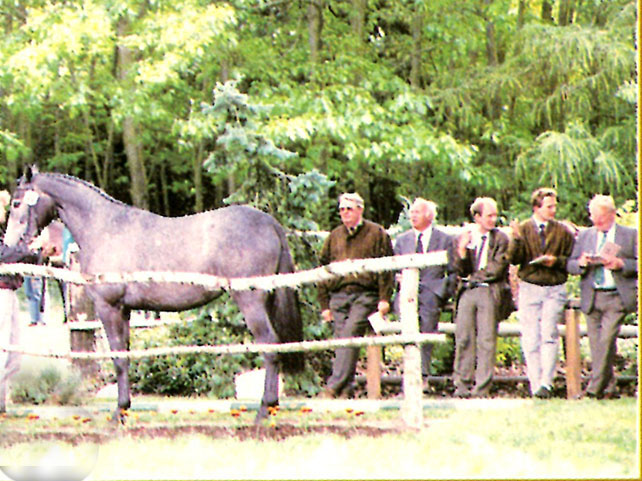
At most shows ribbons are not awarded, but certificates are later issued. The judges can award a la, a 1, or a 2 certificate- and each horse is critically commented on by one of the Commission … and they do not mince their words if they think the horse is showing any real defects – and unlike our showies at home, the breeders seem happy to cop the criticism.
There were fifty six entries in the show we attended in the morning, and straight away, one stood out for us, a lovely bold chestnut three-year-old with a ton of presence by the stallion, Lanthan out of an Akzent mare.
We saw only five daughters of Lanthan (each time out of mares from the influential Trakehner line of Abglanz) but we liked them all.
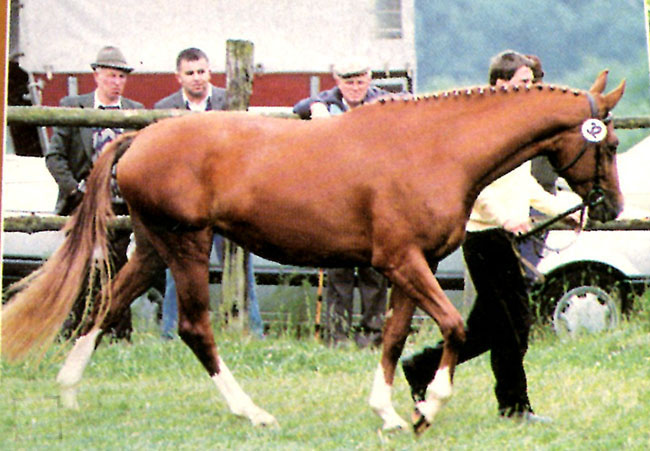
The Lanthan / Akzent filly takes both a la and State Premium at the head of the line, but is beaten for the Best of Show by a daughter of another of the most influential sires of recent times – Bolero.
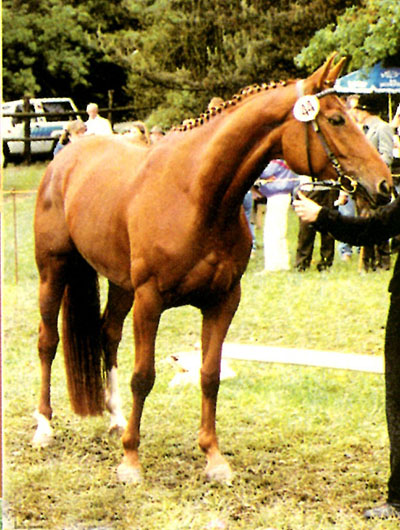
The winning filly by Bolero
Sadly for the Hanoverian breed Bolero died suddenly, but it is hoped that his sons can carry on the line for the limited stock of frozen Bolero semen has already been used up.
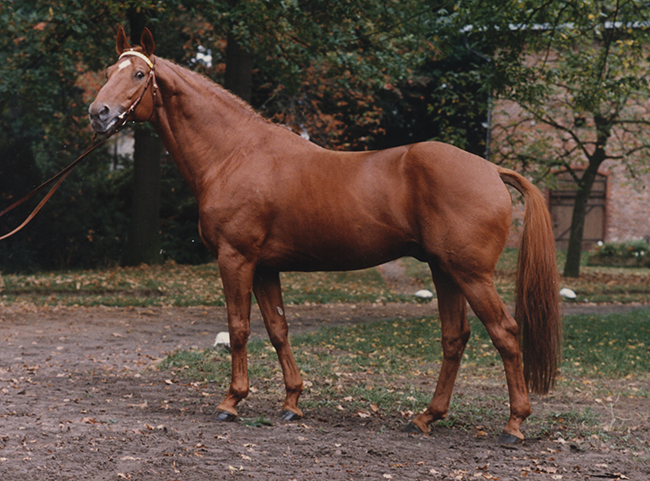
Bolero – died way too young…
If someone had told you that the winner was a young Thoroughbred in work, you would not have doubted them, and this is not so surprising, since Bolero is by the Thoroughbred stallion Black Sky (of the Djebel family). Bolero’s dam , Baronesse is by the Thoroughbred stallion, Bleep and out of a mare by Athas, whose mother was a Thoroughbred, and whose father traces. to one of the important old Hanoverian lines – the A line – founded by the Thoroughbred, Adeptus who stood until l904!
If Mandelsloh is a little out-of-the-way show, Verden in the afternoon in definitely the big league, and not surprisingly, many of the mares are by the local superstar Wenzel 1 – and what lovely horses they are. Refined, elegant and athletic, even if they do tend to a yucky washed out chestnut colour with dark spots!
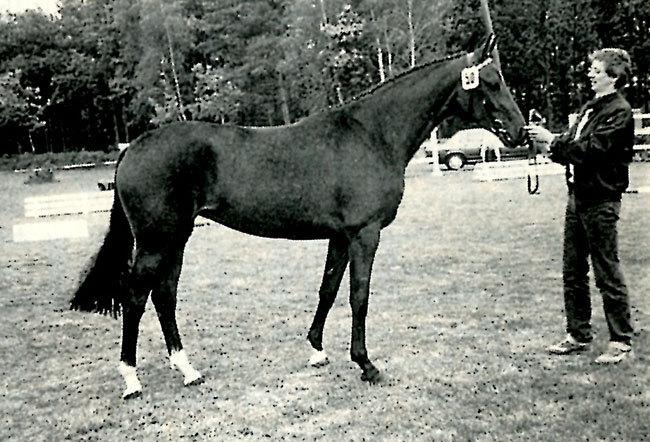
The Wenzel filly takes the two-year-old class
The winner of the two-year-old class is by Wenzel – but the three-year-old class is dominated by Bolero daughters, with three of the top six in the odd numbered three-year-olds being by Bolero. In the Championship, four out of eight are by Wenzel, and the top three are all by the local superstar, with first place going to a stunningly elegant bay four-year-old out of a mare by the influential Thoroughbred sire, Shogun.
Back in 1926 the Trakehner breeders established the first stallion performance test, and two years later the testing station was founded at Celle. There are two sorts of test at Adelheidsdorf – the eleven month test and the hundred day test.
After the first stallion licensing for two and a half year old stallions, the State Stud at Celle usually buys twenty, and these are joined by another twenty or so from the State rearing farm, and the forty are trained over the next eleven months before being tested.
The stallions owned by private breeders come to Adelheidsdorf in August, for their 100 days of training prior to the test in November. The stallion scores for any one year are only calculated against the standard of the group in which he is tested, so it makes no sense to compare the total score to other years, or the results at other stations – although the individual marks for movement etc, do have some sort of standing on their own.
Research by the Verband shows that there is a good correlation between the tested stallion’s final score and his offspring’s general ability, and a good correlation between his score for dressage index and the dressage potential of his foals – but a POOR correlation between the jumping index, and the jumping ability of his foals (which may explain why the currently most successful Hanoverian sire of showjumping horses, Grannus, almost failed his stallion test!) – although there is a very high correlation between the stallion’s free jumping score and the jumping talent of his offspring.
Thoroughbred stallions coming into the Hanoverian band are considered on the basis of their racing career and are not required to do a performance test.
“It would be silly to expect a mature stallion after a racing career to do a test for a three-year-olds, and we would run the risk of missing out on the influence of the best Thoroughbred stallions if we tested them this way,” Ludwig Christmann of the Verband explained.
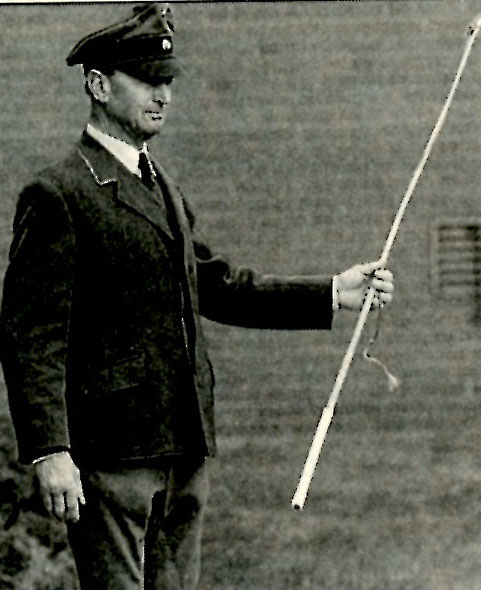
Herr Manfred Loppe
We were greeted at Adelheidsdorf by Herr Manfred Loppe who has been forty years at the Stallion Station, and twenty-five of those as the Director. He is an utterly charming, and· enthusiastic man, and is deservedly very proud of his stallions.
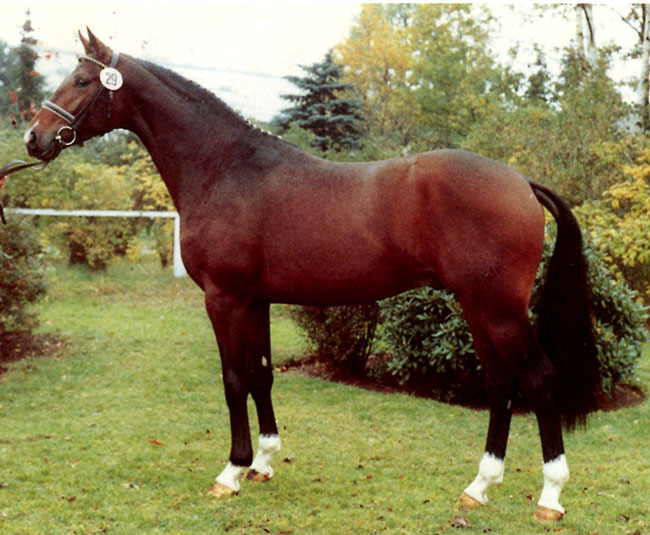
Buenos Aires by Bolero out of an Argentan mare
The first stallion he showed us was Buenos Aires, the champion stallion at last year’s two and a half year old licensing. A handsome bay by Bolero out of an Argentan mare – he was all class!
The next was an elegant Wenzel son out of an Absatz mare who showed super suspension and rhythm. And just in case the tractors all broke down on the same day, the Stud has Gary Cooper (by Gralsritter) – a massive clumfer of the old type.
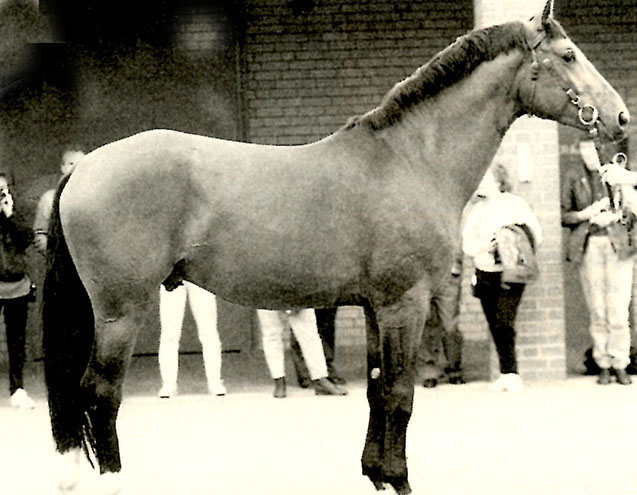
Gary Cooper – a clumfer?
And which did Herr Loppe prefer, the heavy or the lighter horse?
“The lighter type is dominating for sure, but we should always keep a couple of this type,” he said pointing to Gary Cooper, “They may not be fast enough for international competition but they have ability and potential that we must keep. It is important to breed this sort of stallion to mares with some Thoroughbred blood, then you breed an interesting type. Breed him to mares like himself, and you get elephants!”
The stallions at Adelheidsdorf not only work in the big indoor arena – there is a lovely cross country track set up, on good sandy soil, and here they are prepared for the first part of their Performance Test.
The eleven month candidates must cover a 6000 metres cross country jumping course, followed by 2000 metres of fast gallop – the 100 Day stallions do a 4000 metre cross country, followed by a 1000 metre gallop.
They also show their basic gaits outdoors, and again indoors as a group, and their freejumping style. They are evaluated by three riders who ride every stallion in the week before the test, and Herr Loppe awards 50% of the stallions marks for temperament and character, as well as potential for dressage and jumping.
It was off to lunch in a cellar at Celle (where the food was very much better than the pun) then back on the bus again to inspect the magnificent old stables that house the 150 or so state stallions at Celle. The buildings are deserted now as all the stallions are out at their respective Stallion Stations, but we take time out to meet Dr Sieme, who is in charge of the frozen semen of the State Stud.
Dr Sieme says that the critical factor is the knowledge of the mare’s vet. All frozen semen is checked and carefully evaluated before it is sent off, and correctly handled the success rate should be something like 50% – with some stallions they have been having success rates as high as 75%, but again and again he emphasizes that the vet must have specialist knowledge of breeding with frozen semen – otherwise the result is a disaster.
Wherever we have travelled we have been warmly greeted, and overwhelmed with hospitality – wine, beer, the inevitable Schnapps, and tables groaning with spargel and hollandaise (it’s the height of the asparagus season), pork, potatoes swimming in butter, and gallons of coffee, but nothing quite prepares you for the welcome from Friedrich Jahncke, the Vice-President of the Hanoverian Verband when we arrive at his farm in the heart of the Lüneburg horse breeding district.
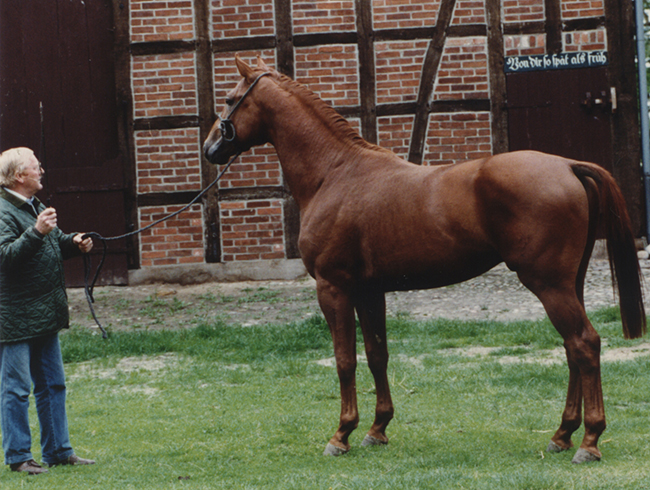
The colt by Watzmann
Herr Jahncke beams with pride as he leads two superb young stallions out of his barn. One chestnut by Watzmann out of an Absatz / Valentino mare and one bay by Don Juan out of an Archidmedes/Der Lowe mare.
He shows us his mares and foals, and then his wife welcomes us to the table in the garden, this time groaning with champagne and orange juice, coffee, and waffles (‘just made by grandmother’ Mrs Jahncke assures us).
On we go to the local breeding station at Splietau where the local committee and the station manager, Obersattelmeister Schoendube welcome us. The President, Horst Seide of the local breeding club, makes a welcoming speech in which he stresses that the breeders in the area have always tried to breed horses for jumping, and that the stallions have been selected for their jumping ability. He is proud that thirty local horses were recently presented as candidates for the elite auction, 27 of whom were by local stallions, and ten were selected.
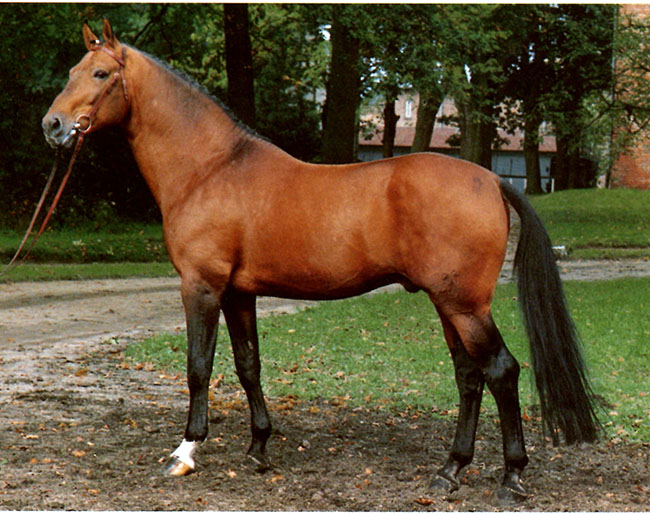
Don Juan by Don Carlos out of a Eljen mare – jumping sire
Their stallions Don Juan and Wienerwald enjoy the highest standings of living sires of auction horses. Herr Seide points out that the soil in the area is of a lighter type and that even in former times when they used the horses for agriculture they bred a lighter type – so when the breeding aims changed, the area already had an advantage.
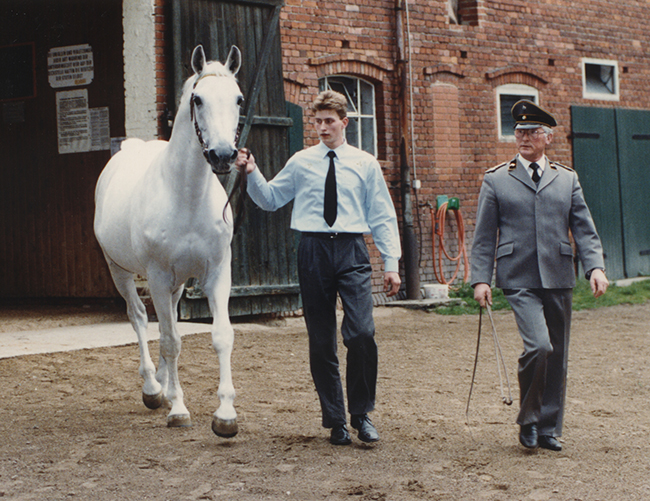
Wienerwald by Widerhall out of an Altenwalde mare
There are five stallions at the Deckstation, and all serve their mares live cover in the time honored way. At the age of twenty the handsome grey Wienerwald has not lost the capacity to awe the viewer. Once again he is big but not coarse and shows the athletic build that has made him one of the most successful sires of jumping horses in Hanover.
After viewing the stallions we go into the little restaurant that is attached to each and every stallion station. As one local points out, the deckstations are the place the farmers have their half holidays. When they bring the mare to breed her to the stallion, things cannot be hurried and what better way to while away the hours than over a glass of beer, discussing horses with friends.
These deckstations are obviously the hub of the social life of the district, and for us they have turned on a grill party or barbeque. Wonderful pork steaks, and sausages, and more steaks and more sausages, with good rich potato salad, and the cholesterol count must be getting fairly spectacular.
We are lucky to share the table with a local breeder Fritz von Blottnitz who speaks impeccable English. Fritz tells us of the local hunting customs, where each year one local sets out carrying a fox tail, followed at a suitable distance by the hunters. They must find their quarry and wrest the fox tail from him – to win the honor of being the fox at the next year’s hunt.
Hunting live quarry is illegal in Germany, so the locals enjoy drag hunting – and Fritz himself breeds his horses with an eye to his favourite equestrian sport – eventing.
Towards the end of the meal he casually asks if we intend going to the Schützenfest.
The Schützenfest?
In all the towns around there is an annual shooting contest to determine the King of the Shooters, and tonight marks the beginning of a three day contest to find the new king.
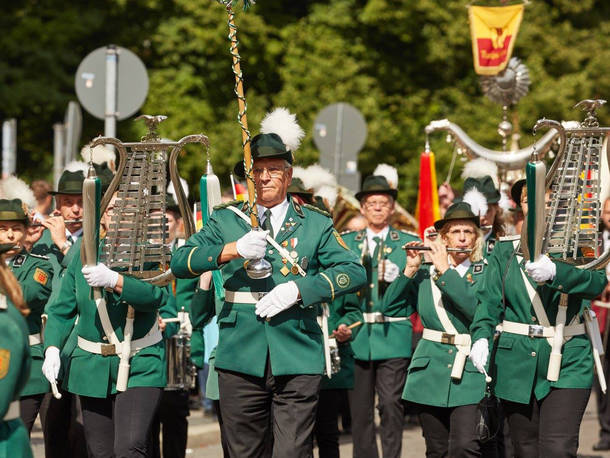
It’s most definitely an offer too good to miss, so there we are lined up with the locals in front of the town hall, at ten thirty at night with a row of dignitaries in front dressed up in uniforms straight out of a Gilbert and Sullivan musical, waiting for the band to arrive, and then the serried ranks of the shooters. They too are all most wonderfully, absurdly decked out, and the band plays a series of stirring tunes as you reflect that Australians could never take themselves seriously enough to hold such a ceremony (which history considered might not be such a bad thing – though we do lack the sort of community spirit such occasions generate).
Back to our resting place for the night, the Hotel Alte Poste, where we do our bit to kick ceremonies along. A cynical Brit who lives locally explains that the contest is a bit of a fix, since the King must pay a fair whack of the cost of the next year’s ceremony, and one of the richer local burgers usually puts out the message that he thinks it is his tum to wear the crown, and foot the bill, and his mates shoot a little to each side of the target.
The festivities will go for the next three days, with innumerable pauses for inexhaustible supplies of refreshment. The band he warns will be striking up a few stirring tunes at precisely 7.30 the next morning. He is not wrong!
There are some lovely horses at the Dannenberg show, but we are most happy to see our friend Fritz take the Champion’s prize with his lovely five-year-old mare, Sinophi.
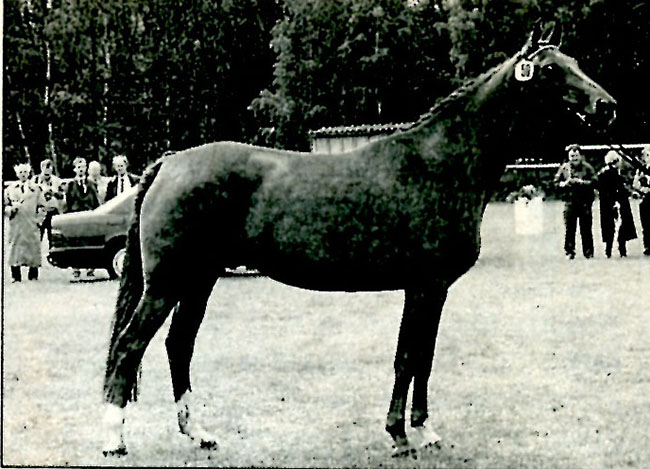
Fritz takes home a ribbon…
In the afternoon we visit yet another mare show at the Hof Bunger – a private stable run by Mr Klaus Bunger- who sold Cindy Ishoy the great Dynasty.
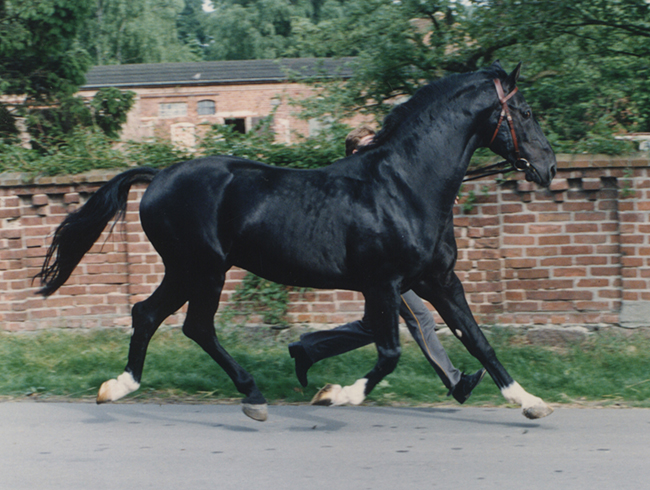
Watussi – by Wedekind out of a Don Carlos mare
In these ranks we see the influence of another up-and-coming sire, Watussi, whose oldest progeny are only three but already making their mark. It’s nice to note too that the young lady who runs out Herr Bunger’s fillies urges them on in a slightly Aussie accent. Diane Thompson is from Hay and has spent the past five years or so in Germany, with a stint in the middle when she took some horses to Mexico and stayed for a while there with them. Hopefully one day she wll come back to Australia bringing her hard won knowledge of the Hanoverian breeding practices with her.
We visit Watussi at the Hanstadt breeding station, and find that for all he is breeding very modern looking horses, he is rather the older type himself, but is still by no means a clumfer.
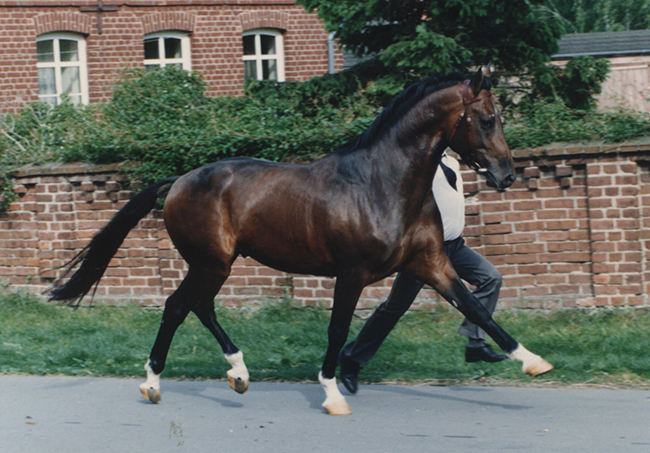
Catching the eye of the Aussies – Grand Seigneur
The real eye catcher of the group is the young stallion Grand Seigneur, a four-year-old son of Grunewald – who looks very like his Thoroughbred grandsire on his mother’s side, Cardinal.
It is at the show at Beedenbostel that we see the filly that Dr Bade (head of the State Stud) describes as ‘almost perfect in type and movement’. A delicate chestnut filly with the most exquisite head and swanny neck that would not have looked out of place on the most refined Thoroughbred but still showing all the athletic grace and movement that we have come to expect from the Hanoverian breed.
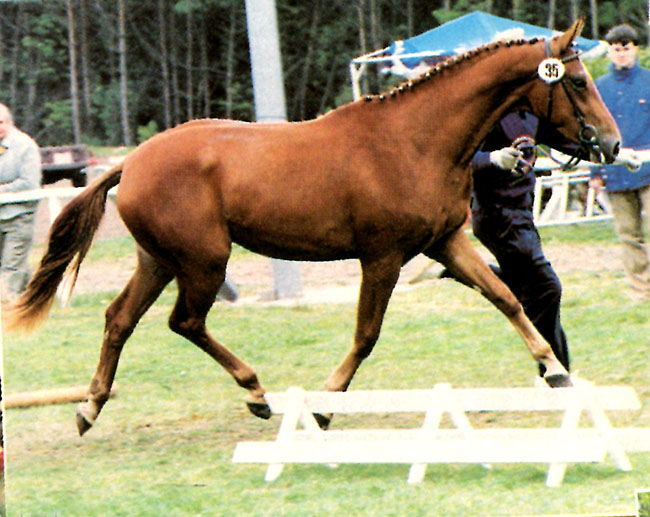
‘almost perfect in type and movement’
She is by the current hottest stallion sensation in the Celle band, Weltmeyer. Only a young stallion, Weltmeyer is by World Cup 1 out of an Absatz mare, and apparently he gets the movement from World Cup, and the typieness from his dam’s Absatz influence.
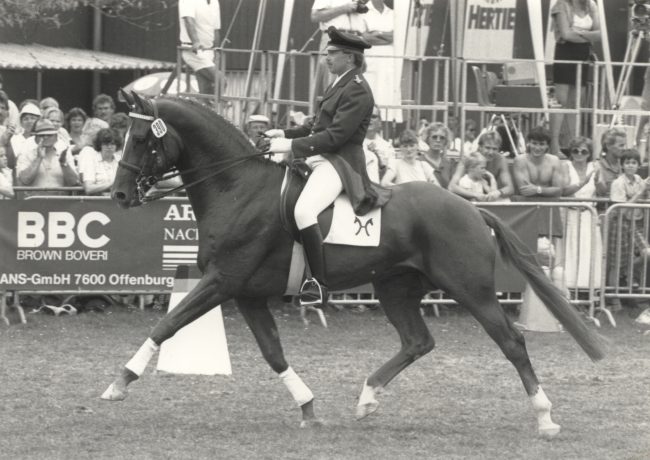
New face on the Hanoverian scene – Weltmeyer
Interestingly the winner of the 5 & 6 year old class is a mare by Absatz, bred some years after the great sire’s death using a precious batch of frozen semen.
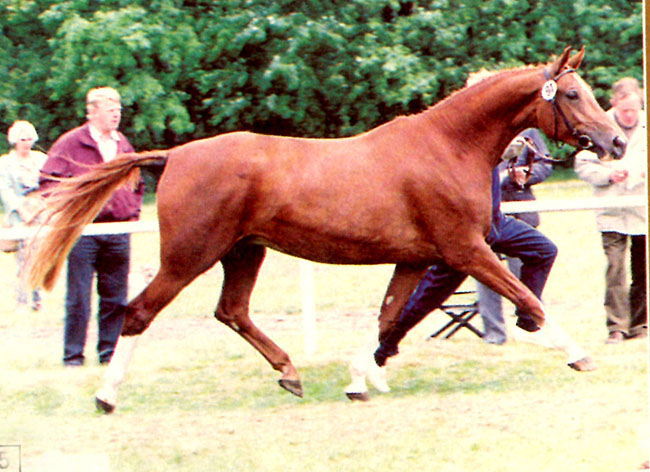
The winner is by Absatz…
At the Beedenbostel Deckstation we see one of the nicest Thoroughbred stallions we have seen in Hanover, the twenty-year-old grand son of Hard Ridden, Neuquen.
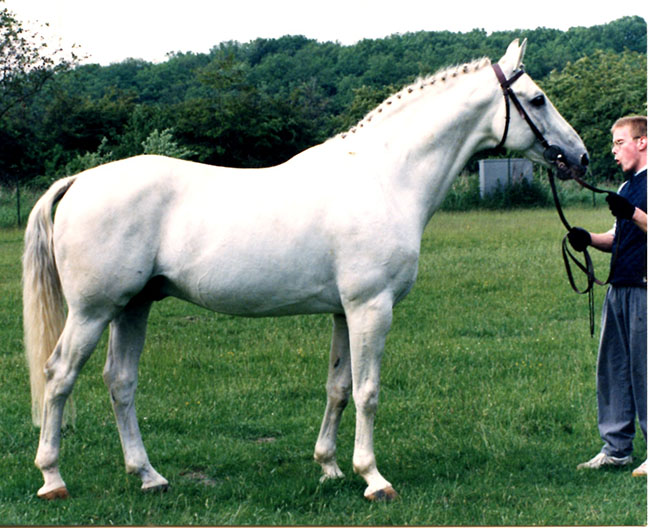
Neuquen xx – bred in France by Hardicanute out of a Right Boy mare
He was introduced into the Hanoverian band at the age of sixteen after standing with one of the other breeding societies where he has already produced two licensed sons and numerous successful competition horses.
Another Bolero son bids well for the future of the line – Bogenschuetze – is a horse with huge, loose movement, and not surprisingly went well in the dressage section of his performance test where he was second out of 34.
At the next stallion station we visit, we see another of the emerging stallion superstars- Western Star. This huge big liver chestnut son of Wenzel 1 is all horse, almost too much horse for the assistant to the station manager who is handling him today. He is full of spirit and just floats across the ground with his huge powerful trot.
At Wittingen mare show it is easy to pick the Western Star progeny – they are stamped with his strength and wonderful big fronts.
Time out for more of the ever so generous hospitality – this time an evening feast laid on by the Wittingen breeding club and an opportunity to quiz the Manager of the Verband, Dr Wilkins, as to the future of the breed.
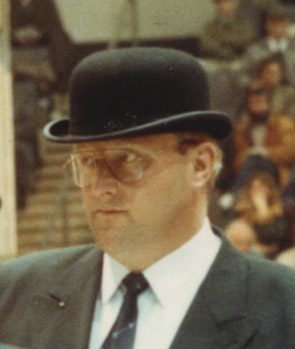
Are the breeders going more towards breeding to dressage lines rather than breeding jumping horses?
“It is a problem. It is easier to show dressage talent at an early age – you can show how well a three-year-old moves. It is harder to show off the talent of a young jumping horse because they need a longer time to mature – so the big prices at the Auctions tend to go to the dressage horses. The show jumpers will pay the biggest prices of all for horses but they often wait until they are competing before they will buy them. So many of our breeders are going to the dressage lines, but we do not as a breed want to get out of the jumping sector of the market. It is a great problem and we are looking at some financial incentives to encourage the breeders to keep breeding to some of the jumping lines.”
And casting your mind back on all the mares you have looked at over the week, which would be your overall Champion?
“Again this is a very hard question without having the horses in front of me, but I think the Weltmeyer filly is the type we are looking for. Weltmeyer was so successful in his Stallion Test, and then at the German Championships as a stallion, that in his first season we had applications for 500 mares to breed to him. So we decided to stand him at stud at Celle for that first season, and breed him AI. We accepted 200 State Premium mares for that first season from many breeding districts, so his foals are all over Lower Saxony.”
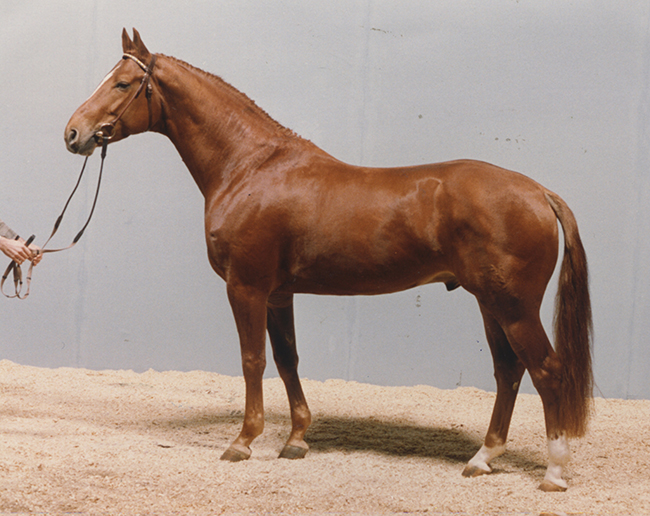
“I have seen four of his crop so far, and they are all very good types. The two-year-old at the show at Beedenbostel was for me the best type – the horse we should breed for in the future.”
The Deckstation Schillerslage is the combination of two earlier stations, and here we see again another of the breeding experiments by the Hanoverian Verband, the limited use of Holstein blood. Here they are standing Loredo, a lovely type of horse by that wonderful old sire, Lord. Because he is a Holsteiner, Loredo is limited in his first year to 50 mares, until the Verband has had time to evaluate his stock (and as a Holsteiner, he must have a stallion performance test score of more than 120 to be accepted into Celle). Currently Loredo is the only Holsteiner in the State Stud.
We end our stallion tour more or less where we started, this time with Wenzel’s full-brother, Wenzel ll – and although he is a heavier horse than his brother, he is a lovely stamp of a horse. Wenzel ll was Champion of his licensing, and then gained the top marks at his Performance Test, and as a result attracted many State Premium mares, but now his offspring are five years old, and they must start to prove themselves in competition.
Because at the end of the day, that is what the whole exercise – the mares shows, the stallion testing, the stallion stations, the breeding clubs – and the Verband – are all about. Breeding competition horses … and my don’t they do it well!



